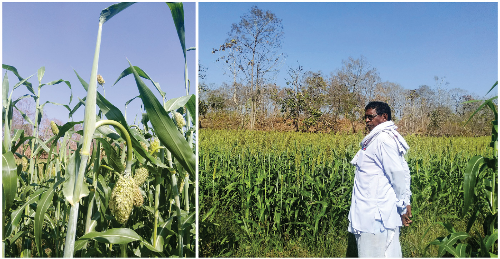Reviving traditional grains
Before the Green Revolution changed cropping patterns all over India, staples like jowar, bajra, jau, ragi were aplenty. These indigenous grains, however, lost out to the hybrids that became the stars of the Green Revolution. Decades later, as generations living off refined flours become victims of diabetics, high blood pressure and other lifestyle disorders, an awakening is taking place. This is the movement across the country to revive out traditional grains. Here is a report by ICRISAT on jowar resuscitation in Telangana.
 गाँव कनेक्शन 2 Nov 2018 5:30 PM GMT
गाँव कनेक्शन 2 Nov 2018 5:30 PM GMT
 (L to R) The characteristic ‘drooping panicle’ of Persa Jonna. A farmer surveying his sorghum field. Photos: Rajani K, ICRISAT
(L to R) The characteristic ‘drooping panicle’ of Persa Jonna. A farmer surveying his sorghum field. Photos: Rajani K, ICRISATIn Sidam Tulsiram's village in Telangana state, India, no festivity or ritual is complete without the traditionally revered jowar (sorghum) grains. Whether it is a wedding, a groundbreaking or the sowing of the first crop of the year in the field, the lustrous white seeds of jowar are filled in a pot, and taken to the village temple and prayers are offered to the Goddess for blessings. This is true for most households in this region.
Persa Jonna (rainy season sorghum) and Sewta Jonna (post-rainy sorghum) play a significant role in the lives of farmers of this area. The grains are much more than just food; they are part of the people's heritage, their beliefs and their way of life. And yet, today these grains are on the verge of disappearing.
Tulsiram, a garrulous, jolly farmer, is head of the Pataguda village in Adilabad District, who even at the age of 60 plus years, likes to work the land himself. Like many farmers of the dryland regions of the world (such as Adilabad), he too wages a daily battle against climate change in the form of increasingly higher temperatures, scant and irregular rainfall and degraded soils. The plight of farmers less prosperous, holding lesser land is even worse.
In order to help the struggling farmers adapt to the changing climate, agricultural scientists around the world have been striving to develop better crops with higher yields that can grow with less water and fewer inputs such as fertilizers.
After decades of growing Persa Jonna and Sewta as per tradition, around mid-1970s, farmers in this region were introduced to high-yielding hybrid seeds. Driven by the promise of more bountiful harvests in a shorter time with lesser water than the traditional varieties, farmers were happy to adopt the new seeds.
However, with an increasing number of farmers adopting the high-yielding hybrids, over the next four decades the native landrace (traditionally-grown local crop) Persa Jonna all but disappeared. Knowledge about the crop, its specific traits, nutritive properties etc., are also slowly vanishing, along with the older generation of farmers.
Culturally, this has left a void in the lives of the simple farmers. For them, the indigenous landrace was a vital part of their celebrations, their customs and their diets. Today, the farmers of this region are conflicted – torn between the need for good returns from their fields and the wish to preserve their cultural heritage.
This phenomenon is not restricted to Telangana in India. Across the globe, smallholder farmers are facing the dilemma of choosing between improving their financial status and losing their indigenous agricultural diversity. Researchers and development scientists worldwide are figuring out ways to solve this problem.
Dr Jana Kholova, Crop Physiologist, ICRISAT, and Mr Kumra Vittal Rao, Development of Humane Action (DHAN) Foundation, recently met farmers from villages around Pataguda to get a sense of what the farmers want. The most common comments that were heard were related to how Persa Jonna tastes better and is better suited to the local area and climate. The panicles of this sorghum variety has a 'drooping' tendency, which is an effective defence mechanism against birds.
Farmer participatory varietal selection has shown successful results in many countries. In this method, farmers have a say in the variety they want to select based on their needs and priorities such as better taste, more lustrous seeds, drooping panicle, etc., along with high yields. Adoption of newer varieties is higher when farmers have a higher participatory role to play in the selection of the varieties.
Dr Kholova and Mr Rao hope to include more farmers from Adilabad in the process of selecting suitable varieties of sorghum for growing in their fields, so that the farmers can specify and choose the traits that are most relevant to them. This inclusive and interactive process is expected to increase adoption of improved varieties of sorghum in this remote region, which has not seen much improvement in sorghum production in the past few decades. This will help them to build resilience against climate change without having to completely sacrifice their way of life.
The World Economic Forum, in its Global Risks Report in early 2018, has listed global agricultural and tree biodiversity as a key factor in combating the top five environmental risks facing the world today. Therefore there's a need to be aware of the need to preserve heritage crop seeds along with developing improved varieties for enhancing yields and improving farmers' incomes. (By Rajani Kumar, Communication Officer, ICRISAT)
Link to original story: http://www.icrisat.org/preserving-legacy-grains-the-persa-jonna-story/
Read More: Indian oilseeds sacrificed for cheap imported oils
More Stories




